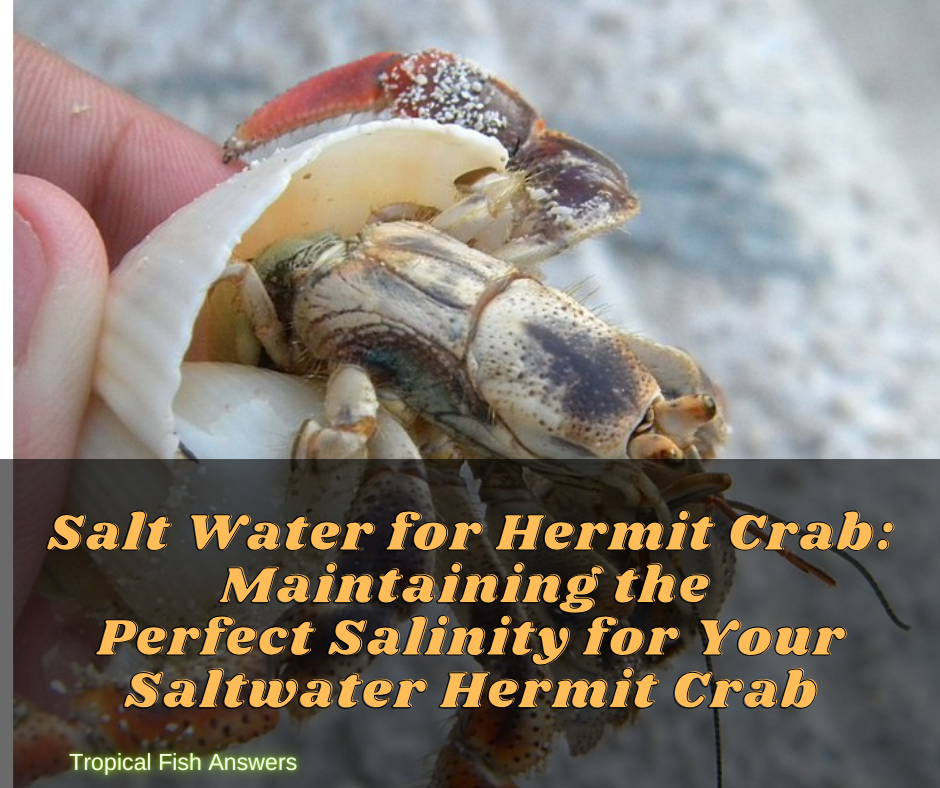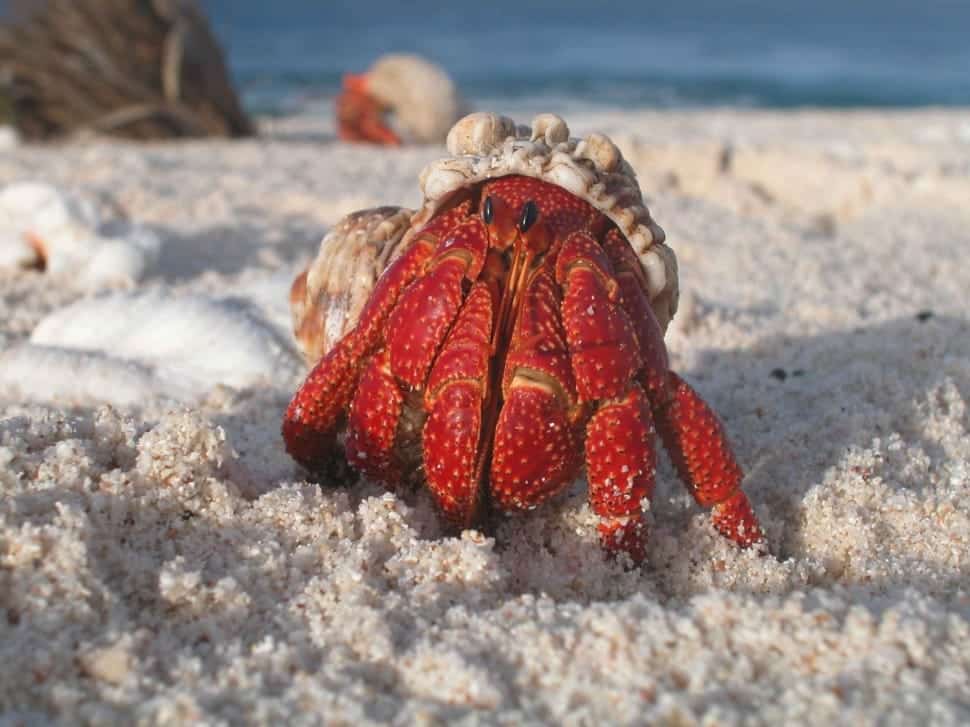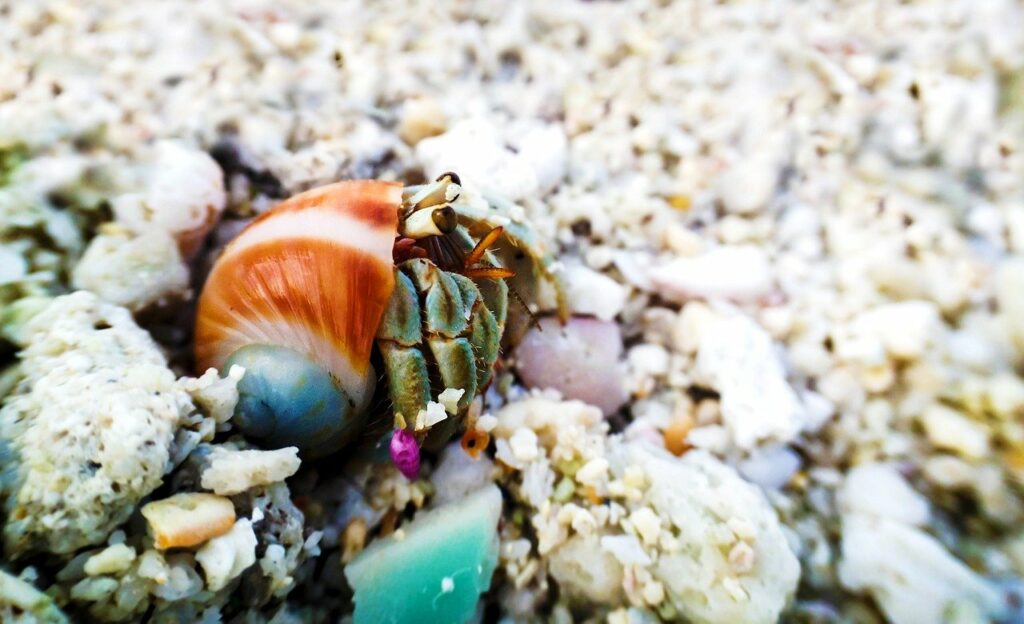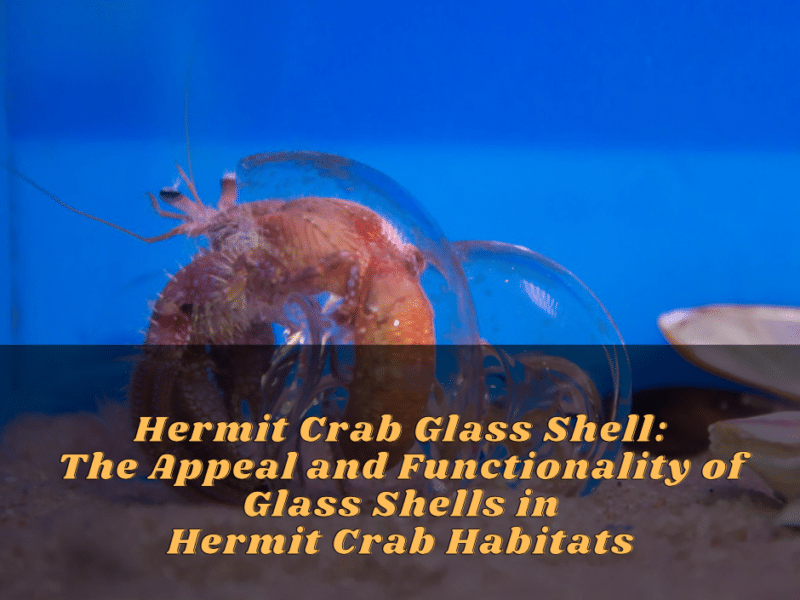Introduction
Saltwater hermit crabs are fascinating creatures that require specific environmental conditions to thrive. One crucial aspect of their care is maintaining the perfect salinity in their water. This article will explore why maintaining the perfect salinity is important for saltwater hermit crabs, as well as the impact of salinity on their health and well-being.
Why Is Maintaining The Perfect Salinity Important For Saltwater Hermit Crabs?
Saltwater hermit crabs inhabit marine environments, and their bodies are designed to function optimally in saltwater. Therefore, it is crucial to replicate their natural habitat when keeping them as pets. By maintaining the perfect salinity, you create a suitable environment that supports their physiological processes and overall well-being.
The ideal salinity range for saltwater hermit crabs is typically between 1.020 and 1.025 specific gravity. This specific gravity measurement refers to the concentration of salt in the water. Maintaining this range ensures that the hermit crabs are not exposed to significant fluctuations in salinity, which can be stressful and detrimental to their health.
The Impact Of Salinity On Hermit Crab Health And Well-being
Salinity plays a vital role in various aspects of a saltwater hermit crab’s health and well-being. Here are a few ways in which salinity affects them:
- Osmoregulation: Saltwater hermit crabs osmoregulate, which means they actively maintain the balance of salts and water in their bodies. Proper salinity allows them to regulate their internal salt and fluid levels effectively.
- Respiration: Hermit crabs have modified gills that allow them to extract oxygen from the water. The correct salinity ensures that their gills function properly, allowing them to breathe efficiently.
- Shell Health: Hermit crabs use empty shells as protection and for support. Maintaining the ideal salinity is crucial for preventing shell degradation, as high salinity levels can erode shell material.
- Immune System: Proper salinity supports a healthy immune system in saltwater hermit crabs. Fluctuations in salinity can weaken their immune response, making them more susceptible to diseases and infections.
- Behavior and Activity Levels: When the salinity is within the optimal range, hermit crabs exhibit normal behavior and activity levels. They will be more active, explore their environment, and engage in natural behaviors that contribute to their overall well-being.
In conclusion, maintaining the perfect salinity is crucial for the health and well-being of saltwater hermit crabs. By replicating their natural habitat and providing the ideal salinity range, you create an environment that supports their physiological processes, respiration, shell health, immune system, and overall behavior. Regular monitoring and adjustments to the water parameters will ensure that your saltwater hermit crabs thrive in their aquatic home.
Understanding Salinity Levels
Maintaining the perfect salinity for your saltwater hermit crab is crucial for their well-being and overall health. As a responsible pet owner, understanding salinity levels and their impact on these fascinating creatures is essential.
What Is The Ideal Salinity Range For Saltwater Hermit Crabs?
The ideal salinity range for saltwater hermit crabs typically falls between 1.020 and 1.025 specific gravity. Specific gravity refers to the concentration of salt in the water. By maintaining the salinity within this range, you create an environment that closely mimics their natural habitat and supports their physiological processes.
It’s important to note that abrupt changes in salinity can be stressful and detrimental to their health. Therefore, regular monitoring is necessary to ensure that the salinity levels remain consistent within the recommended range.
The Importance Of Monitoring And Adjusting Salinity Levels
Regular monitoring and adjustment of salinity levels are crucial to provide the optimal living conditions for your saltwater hermit crab. Here are a few reasons why it’s important:
- Osmoregulation: Saltwater hermit crabs osmoregulate, meaning they actively maintain the balance of salts and water in their bodies. The right salinity levels allow them to regulate their internal salt and fluid levels effectively, promoting their overall well-being.
- Respiration: Hermit crabs have modified gills that allow them to extract oxygen from the water. Maintaining the correct salinity ensures that their gills function properly, enabling efficient respiration.
- Shell Health: Hermit crabs rely on empty shells for protection and support. The ideal salinity prevents shell degradation, as high salinity levels can erode the shell material. Regular monitoring helps ensure that the salinity levels are suitable for maintaining shell health.
- Immune System: Proper salinity plays a vital role in supporting a healthy immune system in saltwater hermit crabs. Fluctuations in salinity can weaken their immune response, making them more susceptible to diseases and infections. By monitoring and maintaining the correct salinity levels, you promote their immune health.
- Behavior and Activity Levels: Saltwater hermit crabs exhibit normal behavior and activity levels when the salinity is within the optimal range. They will be more active, explore their environment, and engage in natural behaviors that contribute to their overall well-being. Regular monitoring and adjustment of salinity levels ensure that they can thrive and be themselves.
In conclusion, maintaining the perfect salinity for your saltwater hermit crab is vital for their health and well-being. By closely monitoring and adjusting the salinity levels within the recommended range, you create an environment that supports their physiological processes, respiration, shell health, immune system, and overall behavior. Remember, providing them with a suitable aquatic home requires responsible ownership and regular attention to their specific needs.
Creating Saltwater For Hermit Crabs
If you’re considering keeping a saltwater hermit crab as a pet, creating and maintaining the perfect salinity in their habitat is crucial for their health and well-being. Understanding the correct salt to water ratio and following a step-by-step guide will ensure that you provide the optimal living conditions for your hermit crab.
The Correct Salt To Water Ratio For Hermit Crabs
The ideal salinity for saltwater hermit crabs is typically achieved by using marine aquarium salt mix. This specially formulated mix is available at pet stores and contains the necessary minerals to provide a suitable environment for your hermit crab. The recommended salt to water ratio for hermit crabs is about 1 tablespoon of marine salt mix per gallon of water. It is important to note that using regular table salt or sea salt is not recommended, as they do not contain the proper minerals and can be harmful to your hermit crab.
Step-by-step Guide To Making Saltwater For Your Hermit Crab Habitat
- Gather the necessary materials: You will need a clean container or bucket, marine aquarium salt mix, a hydrometer or refractometer to measure salinity, and water that is free from chlorine or harmful chemicals.
- Prepare the water: Fill the container with the appropriate amount of water based on the size of your hermit crab habitat. It is recommended to use dechlorinated or distilled water to ensure the best quality for your pet.
- Add the marine salt mix: Following the instructions on the packaging, carefully measure and add the appropriate amount of marine salt mix to the water. Stir the mixture vigorously to ensure the salt is fully dissolved.
- Check the salinity level: Use a hydrometer or refractometer to measure the salinity of the water. The specific gravity should fall within the ideal range of 1.020 to 1.025. Adjust the salinity by adding more marine salt mix or water as needed.
- Allow the saltwater to age: It is recommended to let the saltwater sit for 24 hours before introducing it to your hermit crab habitat. This aging process allows any chlorine or other chemicals to dissipate, ensuring a safer environment for your pet.
- Monitor and maintain salinity: Regularly check the salinity of the water using a hydrometer or refractometer. Make adjustments as necessary to keep the salinity within the recommended range.
By following these steps, you can create and maintain the perfect saltwater environment for your hermit crab. Providing them with the proper salinity will support their osmoregulation, respiration, shell health, immune system, and overall behavior. Remember to regularly monitor and adjust the salinity levels to ensure the well-being of your saltwater hermit crab.
Salt Water for Hermit Crab – Implementing Saltwater In The Tank
When keeping a saltwater hermit crab as a pet, it is crucial to create and maintain the perfect salinity in their habitat for their health and well-being. Introducing saltwater and ensuring the right conditions are maintained require some essential steps. Here, we will explore how to introduce saltwater to the hermit crab habitat and provide tips for maintaining the right conditions in the tank.
How To Introduce Saltwater To The Hermit Crab Habitat
- Prepare the Tank: Ensure that the tank is clean and free from any harmful substances. Rinse the tank thoroughly to remove any residues or contaminants that might impact the water quality.
- Gradual Transition: When introducing saltwater for the first time, it is important to do it gradually. Begin by adding a small amount of saltwater to the tank and monitor how the hermit crab responds to it. Slowly increase the amount over a few days until the desired salinity is achieved.
- Monitor Behavior: Observe the hermit crab’s behavior and interaction with the saltwater. They should be able to adapt to the new salinity without any signs of distress or discomfort. If you notice any unusual behavior, consult a veterinarian or a hermit crab expert for guidance.
Tips For Maintaining The Right Conditions In The Tank
- Regular Water Testing: Regularly test the salinity level using a hydrometer or refractometer. The ideal salinity range for saltwater hermit crabs is between 1.020 to 1.025 specific gravity. Make adjustments as necessary to keep the salinity within this range.
- Water Changes: Perform regular water changes to maintain the water quality. Replace a portion of the tank’s water with freshly mixed saltwater to ensure a healthy environment for your hermit crab.
- Temperature and Humidity: Maintain the appropriate temperature and humidity levels in the tank. Hermit crabs thrive in a temperature range of 75-85°F (24-29°C) and a humidity level of 70-80%. Use a thermometer and hygrometer to monitor these conditions and make adjustments if necessary.
- Proper Filtration: Invest in a good quality filtration system to keep the water clean and free from debris. Regularly clean and maintain the filtration equipment to ensure its effectiveness.
- Provide Hiding Spots: Create hiding spots in the tank to mimic the hermit crab’s natural habitat. This will provide them with a sense of security and reduce stress.
By following these tips, you can ensure that your saltwater hermit crab has the optimal living conditions. The right salinity, temperature, humidity, and cleanliness of the tank are essential for their overall well-being. Regular monitoring and maintenance will contribute to a happy and healthy hermit crab.
Monitoring And Observing Hermit Crab Behavior
Regularly monitoring and observing your saltwater hermit crab’s behavior is crucial for maintaining their health and well-being. By paying attention to their actions and reactions, you can identify any potential issues and take appropriate action. In this section, we will explore the significance of regularly observing your hermit crab’s behavior and discuss the indicators of their health and well-being.
The Significance Of Regularly Observing Hermit Crab Behavior
Observing your hermit crab’s behavior on a regular basis allows you to spot any changes or abnormalities that may indicate a health problem or discomfort. Hermit crabs are sensitive creatures, and even minor changes in their behavior can be significant. By being vigilant and attentive, you can address any issues promptly and ensure the overall well-being of your pet.
Indicators Of Health And Well-being In Saltwater Hermit Crabs
- Activity level: Healthy hermit crabs are active and explore their environment. They move around, climb, and interact with their surroundings. If you notice a sudden decrease in activity or prolonged periods of inactivity, it could be a sign of an underlying issue.
- Appetite: Regular feeding is essential for the well-being of your hermit crab. They should eagerly consume their food and show an interest in eating. A noticeable decrease in appetite or refusal to eat may indicate a health problem.
- Shell hygiene: Hermit crabs rely on their shells for protection and comfort. They should regularly change shells, and their chosen shells should be clean and free from debris or damage. Pay attention to any signs of abnormal shell behavior, such as a crab refusing to come out of its shell or staying inside for extended periods.
- Movement and mobility: Observe how your hermit crab moves and walks. They should have a smooth and coordinated movement. Any signs of difficulty in walking or dragging of limbs could indicate an injury or illness.
- Interaction with tankmates: If you have multiple hermit crabs in the same tank, observe their interactions. They should coexist peacefully, without any signs of aggression or excessive territorial behavior.
- Appearance: Healthy hermit crabs have vibrant colors and a shiny exoskeleton. Any changes in color, texture, or abnormalities on their body, such as lesions or spots, should be noted and investigated.
If you notice any concerning changes or unusual behavior, it is important to consult a veterinarian or a hermit crab expert for guidance. Regular observation and monitoring of your hermit crab’s behavior will help you maintain their well-being and provide appropriate care when needed. Remember, a happy and healthy hermit crab relies on your attentiveness and care as their owner.
Common Questions And Misconceptions About Saltwater For Hermit Crabs
When it comes to maintaining the perfect salinity for your saltwater hermit crab, there are some common questions and misconceptions that arise. Let’s address them to ensure you have accurate information and can provide the best care for your pet.
Do Hermit Crabs Require Saltwater?
Yes, hermit crabs do require saltwater as part of their habitat. They are marine animals that need the minerals and specific salinity levels found in saltwater to properly function and stay healthy. However, it is important to note that they also need a freshwater source for drinking and bathing.
What Salinity Level Is Ideal For Hermit Crabs?
The ideal salinity level for saltwater hermit crabs is between 1.020 and 1.025 specific gravity. This range provides the necessary minerals for their overall well-being. It is essential to use a reliable hydrometer or refractometer to measure the salinity accurately.
Can I Use Table Salt Or Sea Salt For The Saltwater Mixture?
No, you should not use table salt or sea salt for the saltwater mixture. These types of salts may contain additives or impurities that can be harmful to your hermit crab. Instead, it is recommended to use marine salt mix specifically made for aquarium use. This type of salt mix is formulated to provide the necessary minerals and is safe for your hermit crab.
Expert Answers To Frequently Asked Questions
To provide you with expert answers to frequently asked questions about saltwater for hermit crabs, we consulted with hermit crab experts. Here are their insights:
Can I Use Tap Water To Make The Saltwater Mixture?
It is not recommended to use tap water for the saltwater mixture. Tap water may contain chemicals, such as chlorine or chloramine, that can be harmful to your hermit crab. It is best to use purified water, such as reverse osmosis or distilled water, to ensure the water is free from impurities.
How Often Should I Replace The Saltwater?
The saltwater in your hermit crab’s habitat should be replaced every one to two weeks. Regular water changes help maintain the proper salinity and prevent the buildup of toxins. Additionally, make sure to monitor the water quality regularly to ensure it remains within the appropriate parameters.
Can I Add Live Plants Or Corals To The Saltwater Tank?
While live plants and corals can be aesthetically pleasing, they might not be suitable for a hermit crab habitat. Hermit crabs are known to be curious and may uproot or damage live plants or corals, causing harm to themselves or the other inhabitants of the tank. It is best to provide them with appropriate hiding spots and decorations that cannot be easily damaged.
By understanding these common questions and misconceptions about saltwater for hermit crabs, you can ensure you are providing the ideal salinity for your pet. Remember to consult with hermit crab experts or veterinarians for any specific concerns or further guidance to maintain the health and well-being of your saltwater hermit crab.
Common Questions And Misconceptions About Saltwater For Hermit Crabs
When it comes to maintaining the perfect salinity for your saltwater hermit crab, there are some common questions and misconceptions that arise. Let’s address them to ensure you have accurate information and can provide the best care for your pet.
The Key Role Of Maintaining The Perfect Salinity For Saltwater Hermit Crabs
Saltwater is an essential element in your hermit crab’s habitat. They are marine animals that require the minerals and specific salinity levels found in saltwater to properly function and stay healthy. It is important to note that they also need a freshwater source for drinking and bathing. Maintaining the ideal salinity level is crucial for their overall well-being and allows them to thrive in their environment.
Promoting The Health And Longevity Of Your Hermit Crab
The ideal salinity level for saltwater hermit crabs is between 1.020 and 1.025 specific gravity. This range provides the necessary minerals for their overall health and longevity. To ensure accuracy, it is essential to use a reliable hydrometer or refractometer to measure the salinity levels accurately.
It is crucial to use a marine salt mix specifically made for aquarium use when preparing the saltwater mixture. Table salt or sea salt should not be used as they may contain additives or impurities that can be harmful to your hermit crab. Using purified water, such as reverse osmosis or distilled water, is recommended to avoid any chemicals or impurities that may be present in tap water.
Regular water changes are necessary to maintain the proper salinity and prevent the buildup of toxins. The saltwater in your hermit crab’s habitat should be replaced every one to two weeks. Additionally, monitoring water quality regularly and ensuring it remains within the appropriate parameters is important for the health of your hermit crab.
While live plants and corals may be aesthetically pleasing, they may not be suitable for a hermit crab habitat. Hermit crabs are known to be curious and may uproot or damage live plants or corals, causing harm to themselves or other inhabitants of the tank. Providing appropriate hiding spots and decorations that cannot be easily damaged is recommended instead.
By understanding the importance of maintaining the perfect salinity for your saltwater hermit crab and addressing common questions and misconceptions, you can ensure the well-being of your pet. Consulting with hermit crab experts or veterinarians for specific concerns or further guidance is always advisable to provide the best care for your saltwater hermit crab.
FAQ: Salt Water for Hermit Crab: Maintaining the Perfect Salinity for Your Saltwater Hermit Crab
Q: What is the standard salinity level for saltwater aquariums?
A: The standard salinity level for saltwater aquariums is generally considered to be 1.024. However, it’s important to note that the salinity of the oceans can vary in different locations.
Q: How do hermit crabs regulate the salinity of their water?
A: Hermit crabs have the ability to regulate the salinity of their water by drinking fresh water or pumping it into their shells, which then gets mixed with the saltwater.
Q: Is it okay for the saltwater to be as salty as the ocean?
A: Yes, it is fine for the saltwater in your hermit crab’s habitat to have a similar salinity to that of the ocean. However, it’s essential to maintain the balance and not let it become too high or too low.
Q: What salinity level should I aim for when keeping hermit crabs in a saltwater aquarium?
A: It is recommended to keep the gravity and salinity levels between 1.020 and 1.024 for your hermit crabs. This range allows for a healthy and comfortable environment for them.
Q: Can I use Instant Ocean salt mix for my hermit crab’s habitat?
A: Yes, Instant Ocean is a popular brand among hermit crab owners. When mixed half a cup per gallon of water, it provides a consistent and suitable salinity level for your hermit crabs.
Q: Is a specific gravity of 1.028 too high for hermit crab’s saltwater bath?
A: While a specific gravity of 1.028 is on the higher side, it is still considered acceptable for a saltwater bath. However, if you are concerned, you can slightly reduce the amount of salt or add a bit more water to achieve a lower salinity level.
Q: How much salt should I add to achieve the correct salinity for my hermit crab’s habitat?
A: The general guideline is to use half a cup of Instant Ocean salt mix per gallon of water to achieve the recommended salinity level.
Q: Do hermit crabs mix their shell water with both fresh and saltwater?
A: Yes, hermit crabs have the ability to mix their shell water with both fresh and saltwater as they deem necessary. Therefore, maintaining precise specific gravity or salinity levels is not a major concern.
Remember to always monitor the salinity of the water in your hermit crab’s habitat to ensure it remains within a suitable range for their health and well-being.




